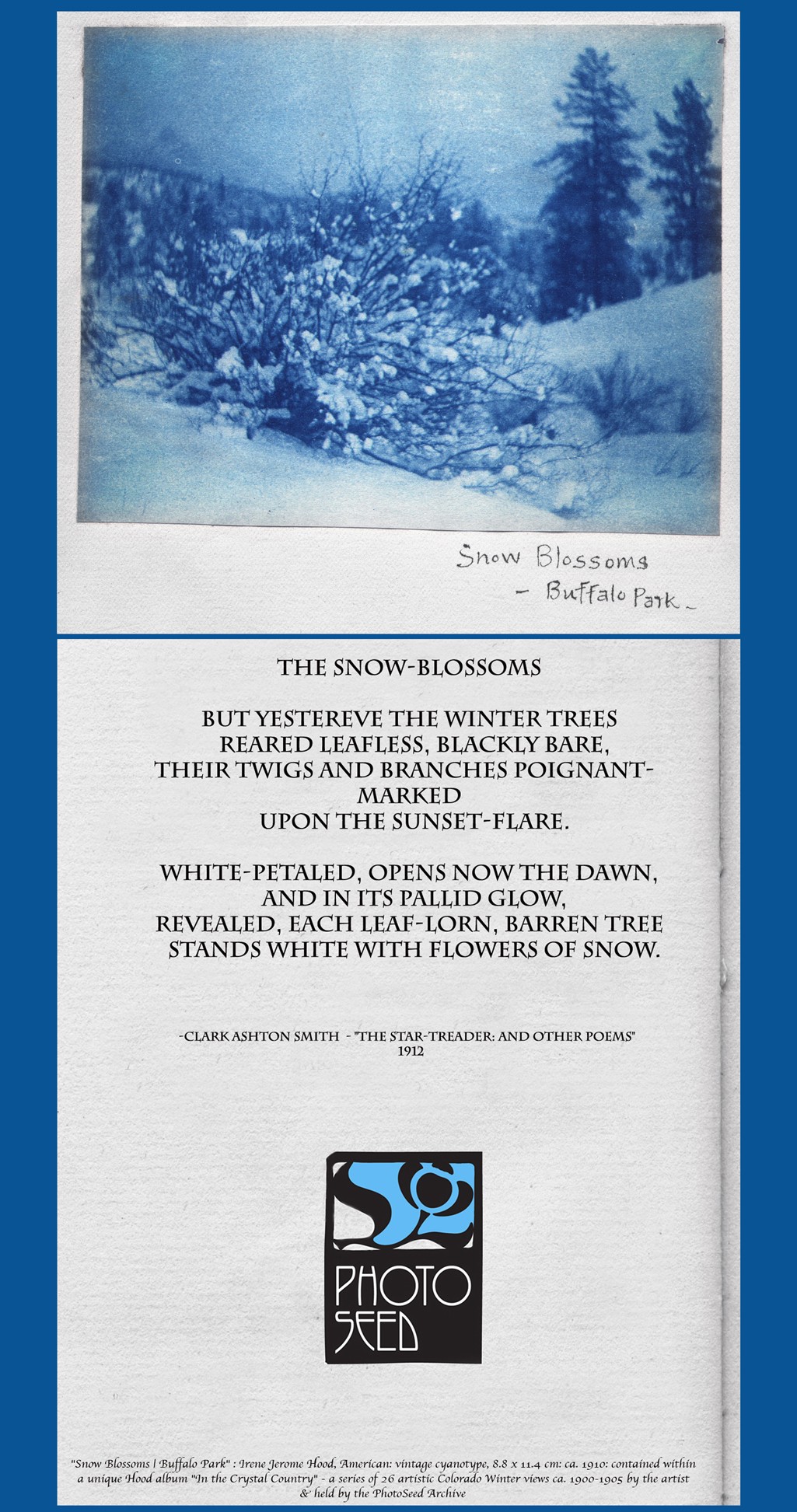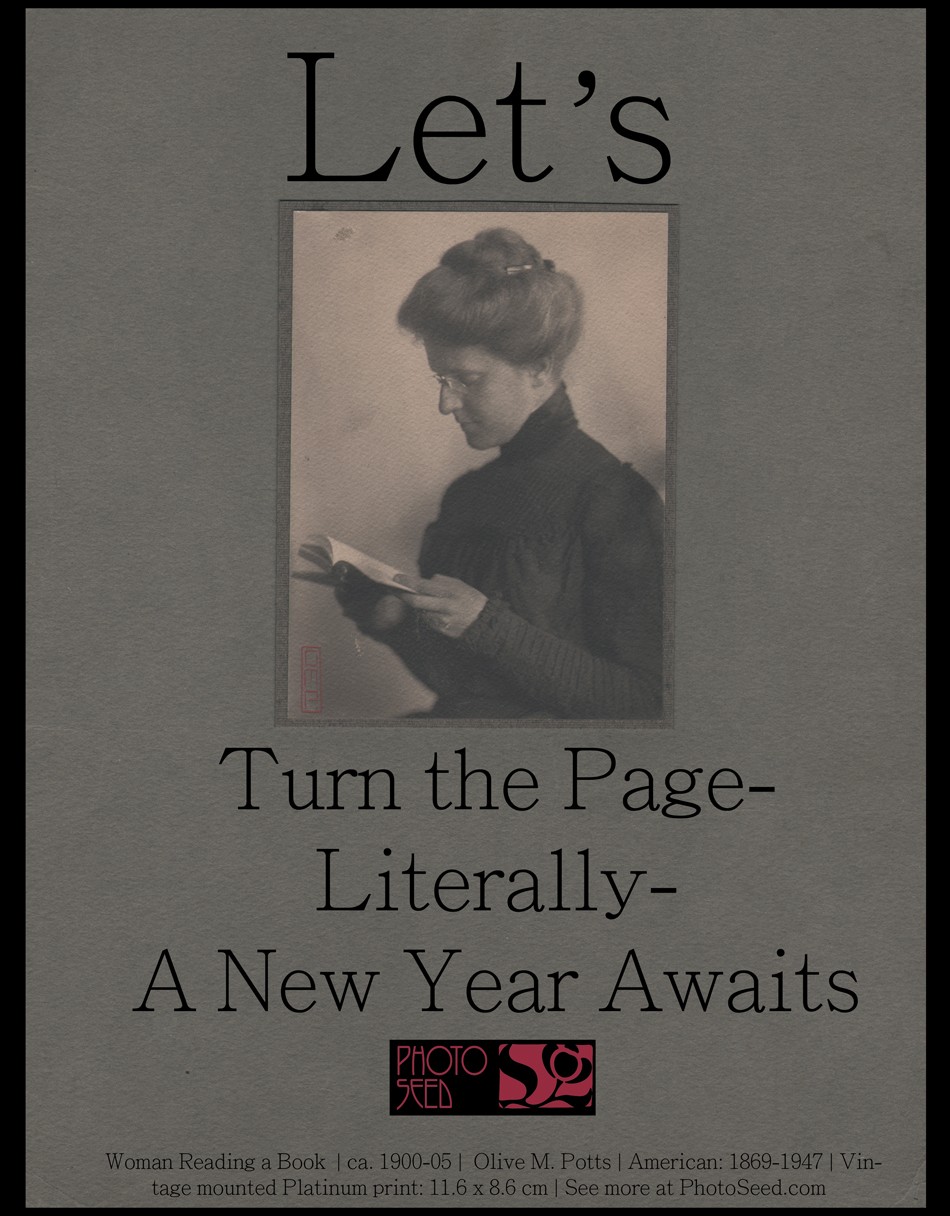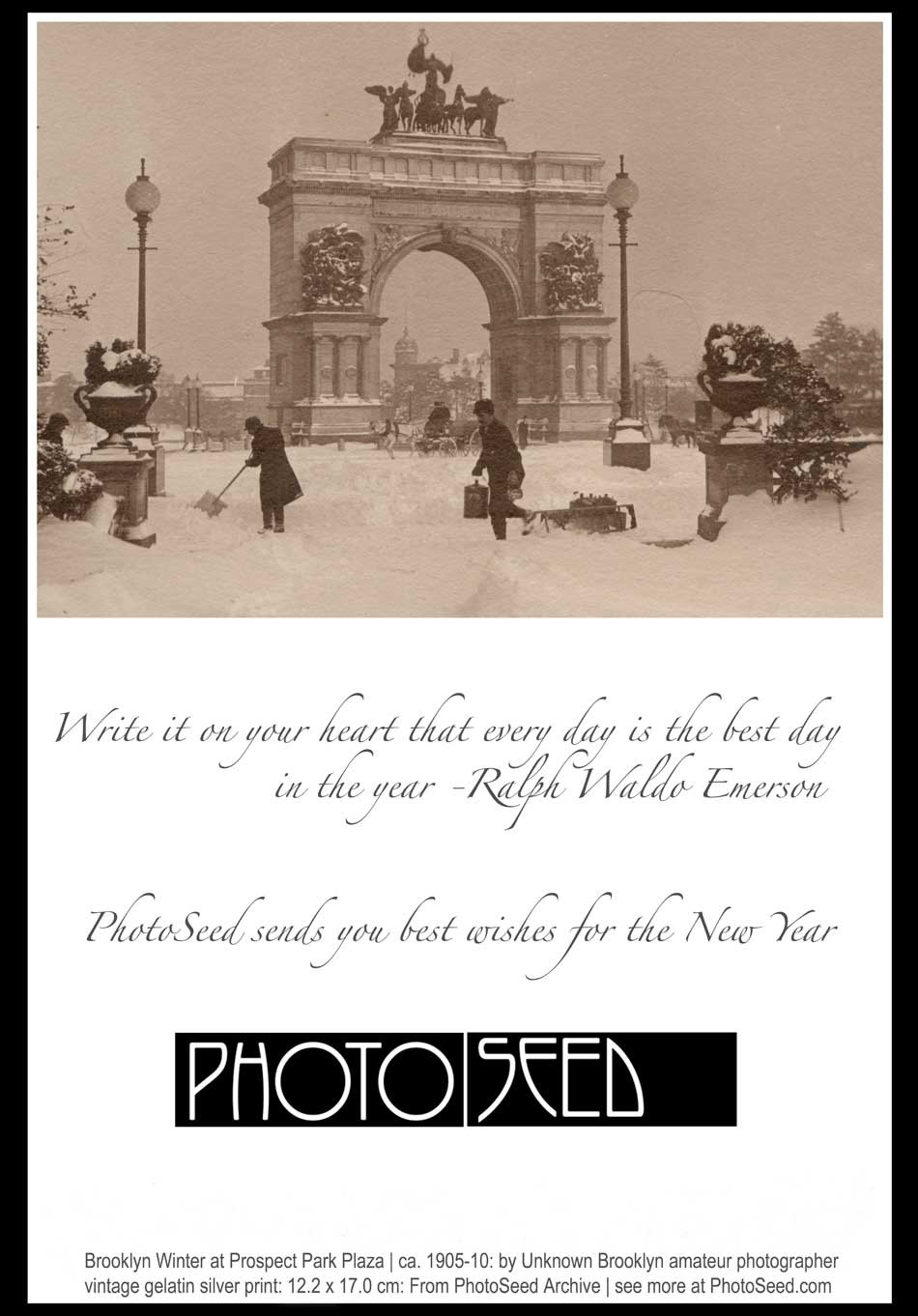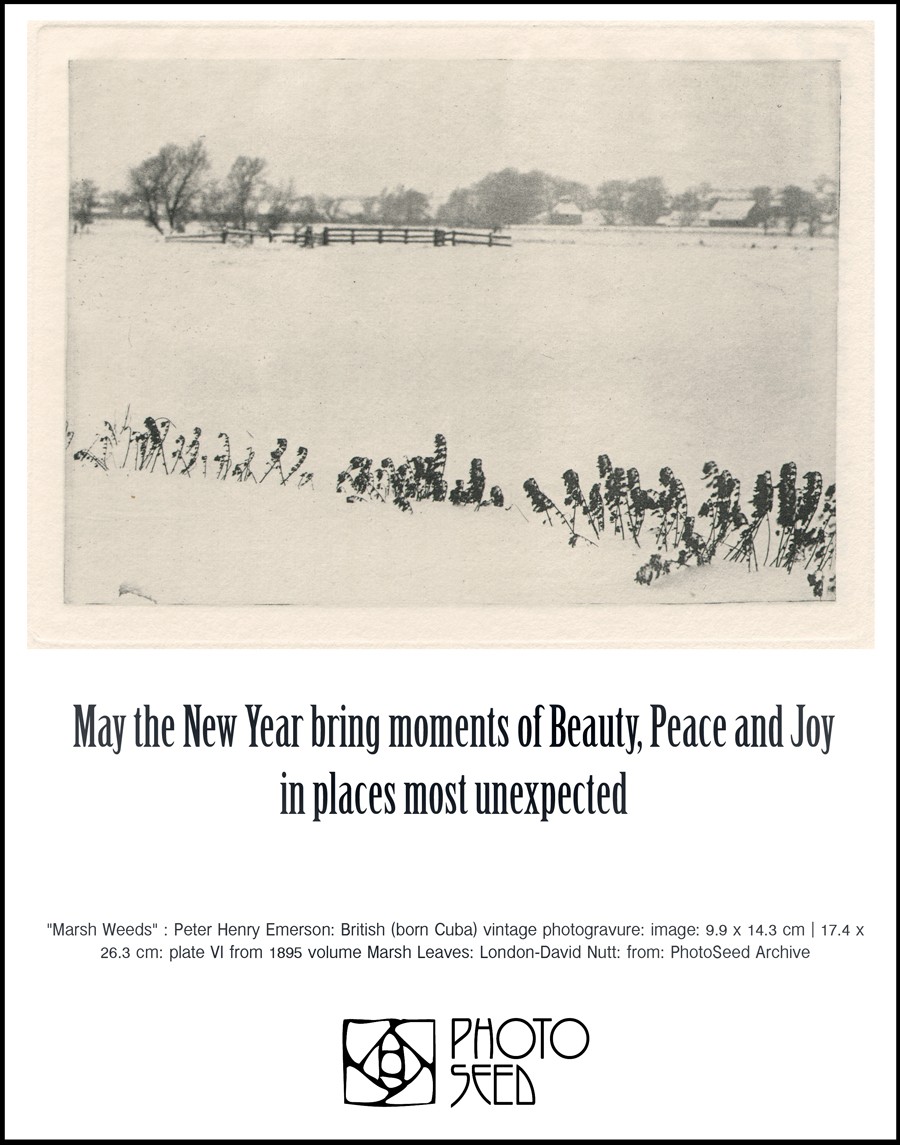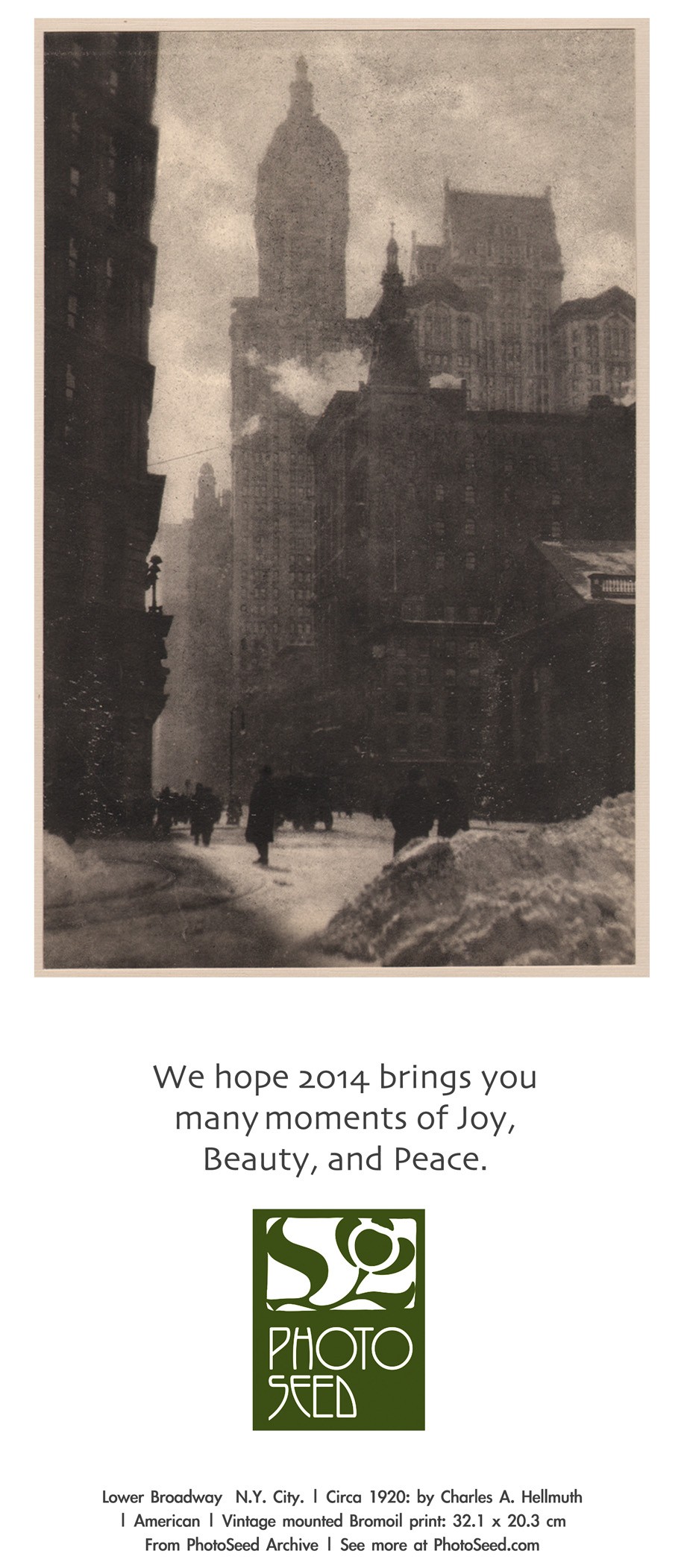Category
PhotoSeed
16 entries in this category | view all categories
Winter Poem
Posted January 2023 in Alternate Processes, Color Photography, Painters|Photographers, PhotoSeed, Texts, Typography
Fortunate Son
Posted February 2021 in Painters|Photographers, PhotoSeed, Texts
At PhotoSeed, we celebrate the life of Ann McElroy Spencer, 1929-2021, one of our most profound influences.
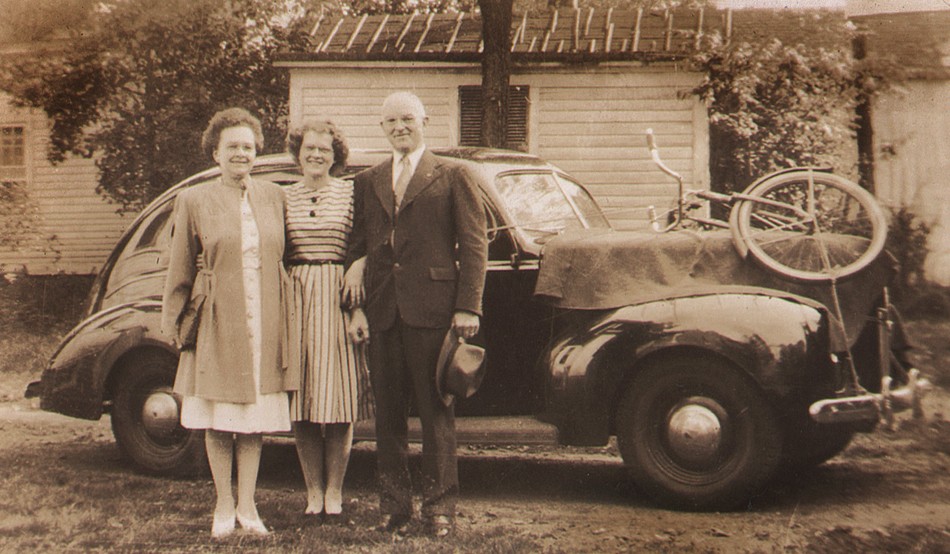 Detail: “Day Ann left for College, Sept. 1946” Jane Ross, American: gelatin silver print: 1946: 9.0 x 15.0 cm. At center, the author’s mother, Ann McElroy, 17, is shown outside her home on South Main Street in Orange, MA flanked by parents James Ernest McElroy (1900-1961) and Edna Sawyer Blanchard (1901-1961). My mom’s bicycle (the color was red) can be seen strapped to the hood of the family car, ready to take her on new adventures and freshman year at the University of Massachusetts at Amherst. Growing up in Orange, my mom was fortunate to have the life-long love of a little sister, my Aunt Jane, and her parents, who were both active and civically engaged in their small New England town. Edna was known by everyone there by her nickname “Happy,” and my grandfather James, recently discharged as a Lieutenant, who served in the United States Navy Reserve in WWII, was the town’s assistant postmaster. Tragically, their lives were cut short in an automobile accident, an event that impacted and shaped the young lives of my mother and aunt. From: Authors family archive.
Detail: “Day Ann left for College, Sept. 1946” Jane Ross, American: gelatin silver print: 1946: 9.0 x 15.0 cm. At center, the author’s mother, Ann McElroy, 17, is shown outside her home on South Main Street in Orange, MA flanked by parents James Ernest McElroy (1900-1961) and Edna Sawyer Blanchard (1901-1961). My mom’s bicycle (the color was red) can be seen strapped to the hood of the family car, ready to take her on new adventures and freshman year at the University of Massachusetts at Amherst. Growing up in Orange, my mom was fortunate to have the life-long love of a little sister, my Aunt Jane, and her parents, who were both active and civically engaged in their small New England town. Edna was known by everyone there by her nickname “Happy,” and my grandfather James, recently discharged as a Lieutenant, who served in the United States Navy Reserve in WWII, was the town’s assistant postmaster. Tragically, their lives were cut short in an automobile accident, an event that impacted and shaped the young lives of my mother and aunt. From: Authors family archive.
Words often fail at times like these, but I wanted to take a few moments to recount one remembrance in the very rich life of my mother, Ann McElroy Spencer, 1929-2021, who passed last week. And it has a photography angle! On a late spring day about 20 years ago, I discovered the true secret of her selfless character, qualities reaffirmed to me in her final years by her fellow residents at the assisted living facility she called home.
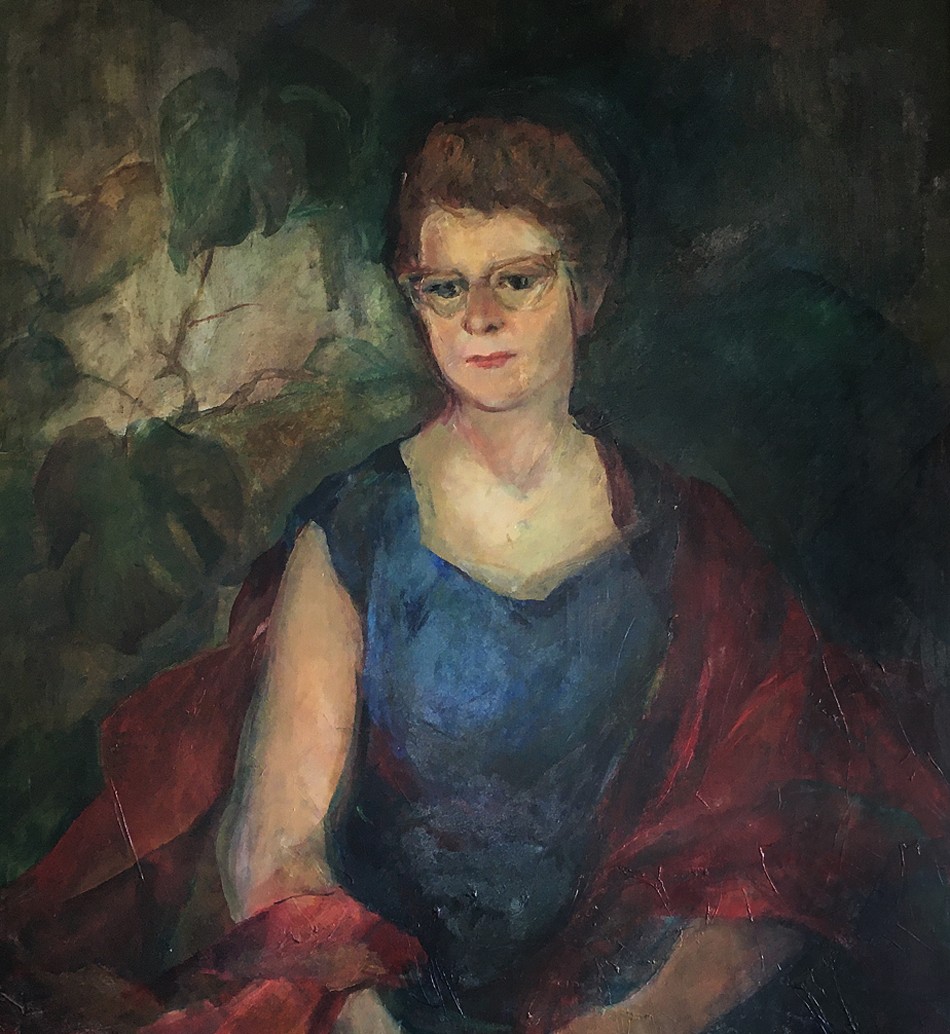 Detail: “Portrait of Ann McElroy Spencer”: Sieglanide “Sissi” Shattuck, American, born Austria: oil on canvas: 1962: 38” x 30” Artist Sissi Shattuck of New Hampshire was a friend of my mother and father in the late 1950s and 1960s. This portrait of my mom, done in her early 30s, always inspired me and it hung for years in the living room of our Connecticut home- the author of this post also had the great fortune to sit for the artist in 1969. From: family collection (artwork © by SissiStudio: sissistudio.com)
Detail: “Portrait of Ann McElroy Spencer”: Sieglanide “Sissi” Shattuck, American, born Austria: oil on canvas: 1962: 38” x 30” Artist Sissi Shattuck of New Hampshire was a friend of my mother and father in the late 1950s and 1960s. This portrait of my mom, done in her early 30s, always inspired me and it hung for years in the living room of our Connecticut home- the author of this post also had the great fortune to sit for the artist in 1969. From: family collection (artwork © by SissiStudio: sissistudio.com)
On that day, she suggested we take a walk around my old neighborhood, where I had grown up but had long since departed for a career in newspaper photojournalism and, in my mind, greener pastures. To my surprise, the walk this day took us up a long steep hill, a bit distant from the route I was expecting. After reaching the summit and turning left, I was hesitant about where the journey would ultimately lead, but she seemed intent, and I did not question, happy to be sharing some good one-on-one time with her.
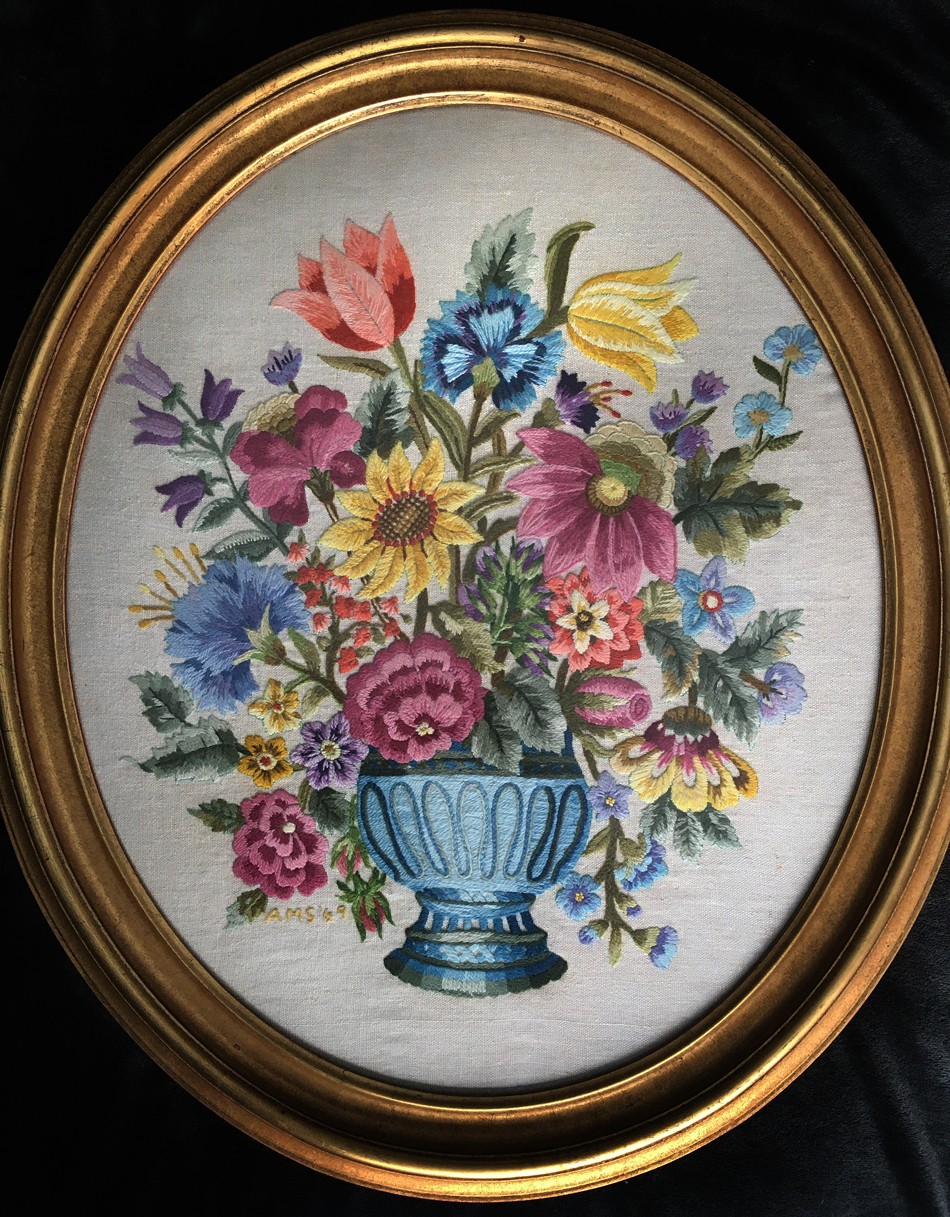 “Crewel Embroidery Flowers in Vase”: Ann McElroy Spencer, American: 1969: 28.25” x 24.25” : dyed wool thread stitched onto linen ground from pattern kit, framed in gilt oval wood frame. My mother learned to sew from her mother at a young age, making her own clothes and things for my brother and me. (Sometimes from the same pattern!) One of my earliest memories as a child was sometime in late 1967, when my mom took on this complex crewel work piece. I found a photo stating it took her 1 1/2 years to finish it, my young self intently following her needle as she worked on the orange and yellow tulips sprouting from the top of the bouquet. From: Authors family collection.
“Crewel Embroidery Flowers in Vase”: Ann McElroy Spencer, American: 1969: 28.25” x 24.25” : dyed wool thread stitched onto linen ground from pattern kit, framed in gilt oval wood frame. My mother learned to sew from her mother at a young age, making her own clothes and things for my brother and me. (Sometimes from the same pattern!) One of my earliest memories as a child was sometime in late 1967, when my mom took on this complex crewel work piece. I found a photo stating it took her 1 1/2 years to finish it, my young self intently following her needle as she worked on the orange and yellow tulips sprouting from the top of the bouquet. From: Authors family collection.
Shortly, we found ourselves in front of an unknown mailbox, in front of a house that was also unknown, at least to me. It was in the next moment, however, that she produced an envelope from somewhere, and proceeded to open the mailbox and deposit the letter within. I casually asked what she was doing and she matter-of-factly stated that earlier that spring, on a previous journey past this mailbox, she had made a mental note to bring along her camera in order to take pictures of flowers growing near it. “A very beautiful display,” or something to that effect, is my recollection of her intent, and reason enough to capture their beauty for eternity, thanks to photography’s magic. She had made prints and placed them in that envelope, intent on sharing them with whomever retrieved the mail at that address—folks that, to the best of my knowledge looking back these many years, were complete strangers. That was my mom. David Spencer-
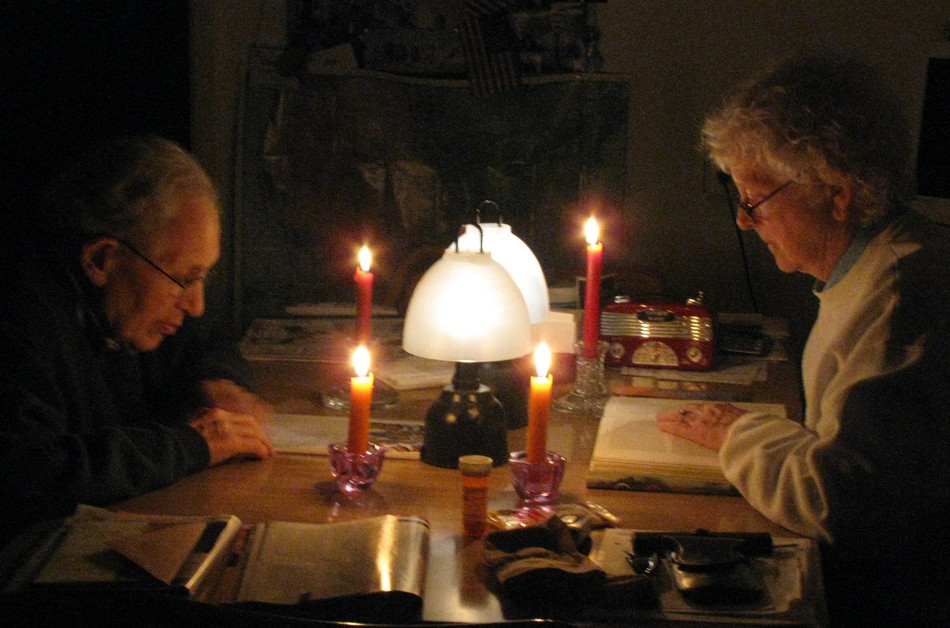 “Ann and Charlie Spencer Reading by Battery & Candlelight”: Photograph by my wife Shannon O’Brien, 2012. During a power outage, my parents keep busy at the kitchen table of their Connecticut home in a favorite pursuit: reading. A long time public educator, one of my mom’s former students wrote this touching condolence: “Mrs Spencer was my 7th grade English teacher who inspired me to become a poet and the love of poetry. We were required to memorize selected poems which to this day I still can recite aloud. She was strict but kind. As a result of her love of the educational world, I also became a teacher of elementary students in Fairfield where we began each day with a poem to read and copy in script.” From: Authors family collection.
“Ann and Charlie Spencer Reading by Battery & Candlelight”: Photograph by my wife Shannon O’Brien, 2012. During a power outage, my parents keep busy at the kitchen table of their Connecticut home in a favorite pursuit: reading. A long time public educator, one of my mom’s former students wrote this touching condolence: “Mrs Spencer was my 7th grade English teacher who inspired me to become a poet and the love of poetry. We were required to memorize selected poems which to this day I still can recite aloud. She was strict but kind. As a result of her love of the educational world, I also became a teacher of elementary students in Fairfield where we began each day with a poem to read and copy in script.” From: Authors family collection.
The Piano Lesson
by Ann Spencer
She was always there, waiting, just inside the door. I came lingeringly up the walk, book-bag bumping against my leg. She opened the door and I sidled past into the dim hall that seemed to smell of old things. “Five minutes late!” she said. I smiled weakly. I followed her into the living room, brushing against the heavy brown velveteen portieres, which helped keep the room warm in winter. She waited silently while I took off my coat and dropped it on the horsehair sofa. The armchairs, each with their antimacassars, stood guard, like sentinels, in their appointed places. Somewhere a clock chimed the quarter hour. It was risky to be late. It was rude to allow her to wait, in expectation, behind the etched glass window of the front door. Promptness was a virtue.
Ida Conrad Babb was Conservatory trained and was one of the two piano teachers in our small New England town. It was the depths of the Depression, and the money she made by giving lessons provided for her groceries: she had no car. She was tenacious of her pupils and held herself stiffly, as if the loss of even one student would cause her to crack and send her to the poor farm on East River Street. I recall her across the gulf of the years, not unkindly, but with some trepidation. She was one of the few adults in my life at the time who evaluated my work. I felt sorry for her- in my way. She was my first piano teacher.
We approached the piano which was housed in an alcove off the living room- a large instrument tucked into a little space, almost like an afterthought. Pulling out the music from my bag, I put Henri Hertz- Scales and Arpeggios on the piano rack. “Well,” she said, “let’s commence with the scales. We have to warm up the fingers first,” and she’d smile so that her slightly protruding teeth showed. I started off, thinking to myself that yesterday when I had practiced scales, I’d said to mother, “Henry Hertz when I do these!” and she had laughed. Now I dutifully sawed through the music- not much facility there- certainly no joy. I was sure she’d give me a “Fair” this week on my report card.
A dog barked somewhere in the back of the house, and I ploughed on through the other studies. “Mind your fingering.” “Commence again- play it at half-tempo.” And again: “You’re not practicing this étude as you ought,” she’d say, reproachfully. Never any praise. It was a relief when she said, “Get that folder, Ann, on top of the piano.” I moved carefully- not much space- and tentatively set aside the framed photograph of her brother killed in World War I. The street she lived on bore his name. I took the folder which contained the pieces. She leafed through the contents and selected one. Now I could sit in her seat by the window and she would sit at the piano and demonstrate how the piece should be played. Spare, erect, hand held above the keyboard- never would she allow them to droop- she played the short composition with fluidity and grace. “Your turn now, “ she said. She seemed happy to restore the piano to me. Never once did I hear her in recital.
After the lesson and after she had meticulously graded my report card- “Fair” for scales and arpeggios, “Very good” for the memorized piece- she told me to go to the kitchen- would I see the dog? to get a note for my parents which would be on the kitchen table. Entering the room, I was suddenly aware of her husband, smoking a pipe in the failing light of a winter’s afternoon. He knew my father, yet he spoke no greeting: a dusty plant, neglected, in a dark corner. I was a little afraid. “Hello,” I said, grabbed the note and didn’t wait for a response.
The tree at the end of her front walk still bore its leaves- sere, clicking against each other in the January wind. “That tree wun’t lose its leaves until spring,” she said. I stumbled back home across the frozen ruts of the two fields which separated our house from hers.
The following week, I commenced piano studies with the other teacher in town. He was a jolly man who emphasized popular tunes over études.
Can We?
Posted January 2021 in New Additions, PhotoSeed
Photograph: Meet Frame
Posted February 2020 in Conservation, Framing, New Additions, Photographic Preservation, PhotoSeed, Significant Photographers
Last August I had the uncommon opportunity to purchase five photographs ca. 1905-1910 that were still in their original picture frames taken by William T. Knox, (1863-1927) then president of the Brooklyn Camera Club.
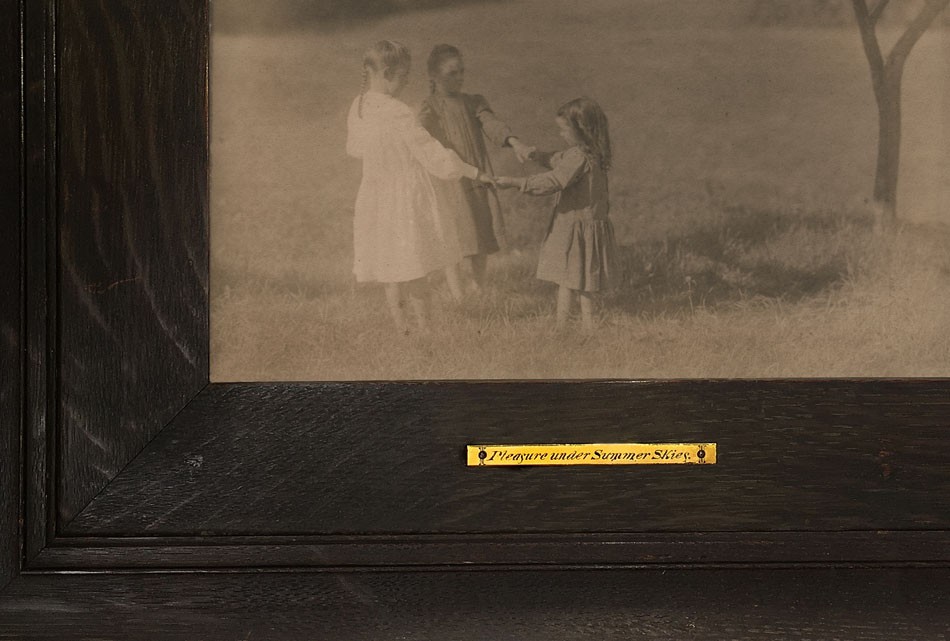 Detail: “Pleasure Under Summer Skies”: William T. Knox, American: (1863-1927) Vintage sepia Platinum print ca. 1905-10; 19.6 x 24.5 | 19.6 x 24.5 cm (flush-mounted on Bristol-board type matrix). Photograph framed in quarter-sawn oak frame with brass title nameplate made by James Engle Underhill, American: (1870-1914) two-piece integrated: 34.5 x 39.5 x 2.0 cm shown with glass removed. “Pleasure Under Summer Skies” dates to 1905, and was initially exhibited in the Second American Photographic Salon, overseen by the American Federation of Photographic Societies under President Curtis Bell. At the time, William Knox was Federation Secretary. From: PhotoSeed Archive
Detail: “Pleasure Under Summer Skies”: William T. Knox, American: (1863-1927) Vintage sepia Platinum print ca. 1905-10; 19.6 x 24.5 | 19.6 x 24.5 cm (flush-mounted on Bristol-board type matrix). Photograph framed in quarter-sawn oak frame with brass title nameplate made by James Engle Underhill, American: (1870-1914) two-piece integrated: 34.5 x 39.5 x 2.0 cm shown with glass removed. “Pleasure Under Summer Skies” dates to 1905, and was initially exhibited in the Second American Photographic Salon, overseen by the American Federation of Photographic Societies under President Curtis Bell. At the time, William Knox was Federation Secretary. From: PhotoSeed Archive
Additionally, three of them were in beautiful wood frames made by his fellow club member James E. Underhill, 1870-1914, who I discovered had made his living as a fine picture framer since around 1900 in New York City at his shop at 33 John Street, at the corner of Nassau Street.
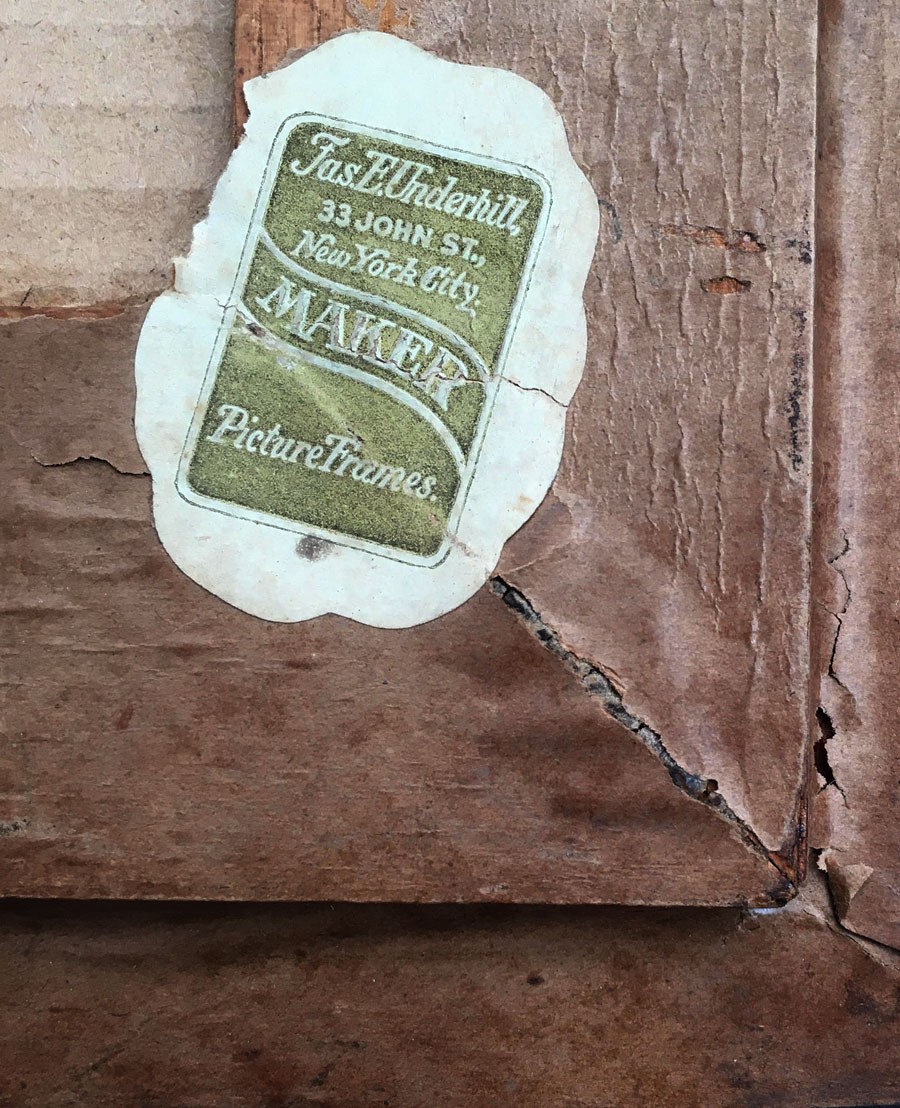 Before limited conservation, the original James E. Underhill white-paper letterpress label in olive-green (2.9 x 2.0 | 4.3 x 3.2 cm) is seen affixed to the frame backing verso of his oak frame enclosing the William T. Knox photograph “Pleasure Under Summer Skies”. Conservation treatment by this archive carefully left this label in place. James Engle Underhill was a fellow member along with Knox at the Brooklyn Camera Club when this photograph was taken and framed. (ca. 1905-10) Underhill’s picture framing shop: “Jas.E.Underhill, 33 John St., New York City. MAKER PictureFrames.” was in operation at this location (corner Nassau) from around 1900 to his death in 1914. From: PhotoSeed Archive
Before limited conservation, the original James E. Underhill white-paper letterpress label in olive-green (2.9 x 2.0 | 4.3 x 3.2 cm) is seen affixed to the frame backing verso of his oak frame enclosing the William T. Knox photograph “Pleasure Under Summer Skies”. Conservation treatment by this archive carefully left this label in place. James Engle Underhill was a fellow member along with Knox at the Brooklyn Camera Club when this photograph was taken and framed. (ca. 1905-10) Underhill’s picture framing shop: “Jas.E.Underhill, 33 John St., New York City. MAKER PictureFrames.” was in operation at this location (corner Nassau) from around 1900 to his death in 1914. From: PhotoSeed Archive
In my 20+ years of collecting photography, and with a definite impression the “bloom is off the rose” when it comes to the intersection of internet commerce, it seems to me today more difficult to acquire vintage photographs of artistic note still in their original frames. This is a pity, because framed photographs left undisturbed from 100+ years ago can often reveal the more honest intent photographers wished for their work to be seen and appreciated- for the time they were created no doubt, but also on a higher aesthetic level.
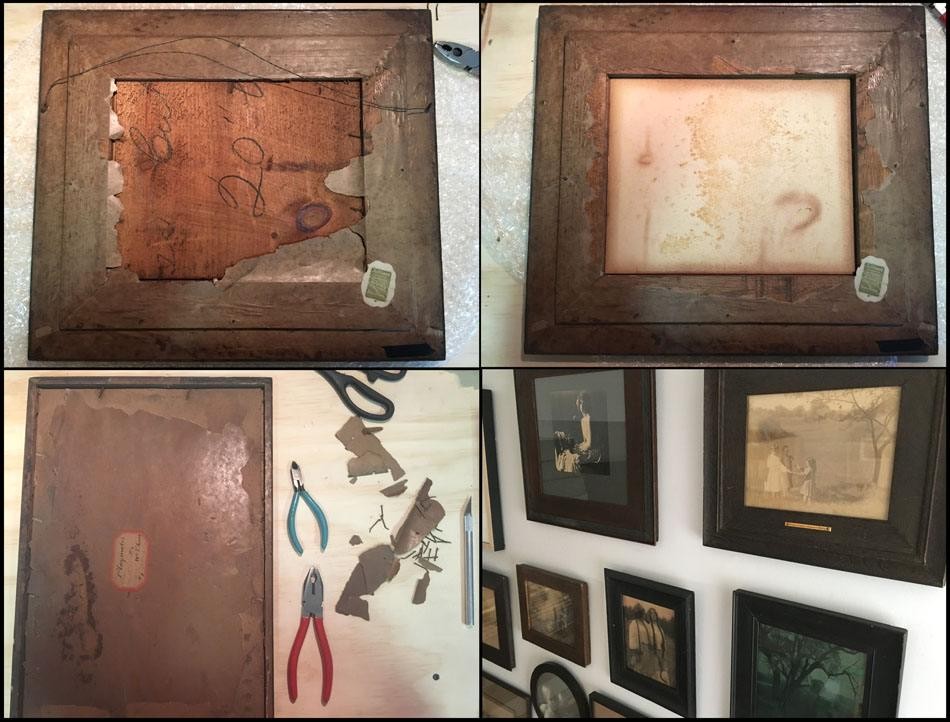 Upper left: When first received by PhotoSeed after purchase in late August, 2019, the verso of the framed William T. Knox photograph “Pleasure Under Summer Skies” is seen in its’ original James E. Underhill oak frame. As was common in framed works from the late 19th and early 20th centuries, a thin sheet of pine wood veneer was used as a backing board, secured by small nails. Upper Right: Conservation treatment on the framed work included removal of this wood backing board along with rusted screw-eyes and wiring used for hanging as well as some of the frame backing paper. The original Underhill framing label is carefully left undisturbed at lower right and the Bristol-board type matrix with flush-mounted photograph on recto is revealed, showing the “burning in” of several wood knot holes from the recto of the original sheet of wood veneer. Next steps included the thorough cleaning of the original framing glass and then cutting a piece of acid-free, 4-ply mat board that would be sandwiched between the photographic matrix and new piece of cardboard backing board. Finally, a Fletcher brand framing gun was used to secure glass, mounted photograph and the two separate backing matrixes using new metal framer’s points to the inside perimeter of the frame verso. Lower Left: Tools at right including small pliers and a wire-cutter were used to remove the original verso framing nails from the William T. Knox photograph “Playmates”, along with an X-Acto knife at far right to cut away the delicate and very acidic backing paper. A unique paper label signed and titled by the artist in the middle of the paper was then carefully removed and preserved within a newly encapsulated frame using a piece of acid-free mat board. New flush-mounted hanging hardware (screw-eyes not recommended!) and braided wire were also installed. Lower Right: A selection shows vintage frames with photographs from the PhotoSeed Archive, including the William T. Knox photograph “Pleasure Under Summer Skies”, now re-installed within its’ original James E. Underhill frame at upper right. To the left of it is a separate frame made by Underhill’s contemporary, George F. Of Jr. (1876-1954) From: PhotoSeed Archive
Upper left: When first received by PhotoSeed after purchase in late August, 2019, the verso of the framed William T. Knox photograph “Pleasure Under Summer Skies” is seen in its’ original James E. Underhill oak frame. As was common in framed works from the late 19th and early 20th centuries, a thin sheet of pine wood veneer was used as a backing board, secured by small nails. Upper Right: Conservation treatment on the framed work included removal of this wood backing board along with rusted screw-eyes and wiring used for hanging as well as some of the frame backing paper. The original Underhill framing label is carefully left undisturbed at lower right and the Bristol-board type matrix with flush-mounted photograph on recto is revealed, showing the “burning in” of several wood knot holes from the recto of the original sheet of wood veneer. Next steps included the thorough cleaning of the original framing glass and then cutting a piece of acid-free, 4-ply mat board that would be sandwiched between the photographic matrix and new piece of cardboard backing board. Finally, a Fletcher brand framing gun was used to secure glass, mounted photograph and the two separate backing matrixes using new metal framer’s points to the inside perimeter of the frame verso. Lower Left: Tools at right including small pliers and a wire-cutter were used to remove the original verso framing nails from the William T. Knox photograph “Playmates”, along with an X-Acto knife at far right to cut away the delicate and very acidic backing paper. A unique paper label signed and titled by the artist in the middle of the paper was then carefully removed and preserved within a newly encapsulated frame using a piece of acid-free mat board. New flush-mounted hanging hardware (screw-eyes not recommended!) and braided wire were also installed. Lower Right: A selection shows vintage frames with photographs from the PhotoSeed Archive, including the William T. Knox photograph “Pleasure Under Summer Skies”, now re-installed within its’ original James E. Underhill frame at upper right. To the left of it is a separate frame made by Underhill’s contemporary, George F. Of Jr. (1876-1954) From: PhotoSeed Archive
On a technical note, PhotoSeed does minimum conservation on framed works when they enter the collection. The mantra of “do no harm” as well as the realization of being temporary custodians of an archive is embraced. When in doubt about proceeding with photographic conservation, advice given me many years ago from a George Eastman Museum conservator to basically just leave things alone when unsure of how to proceed is something I’ve always kept in mind. Of course, the financial realities of proper conservation standards will always be at the forefront for collectors, both private and institutional.
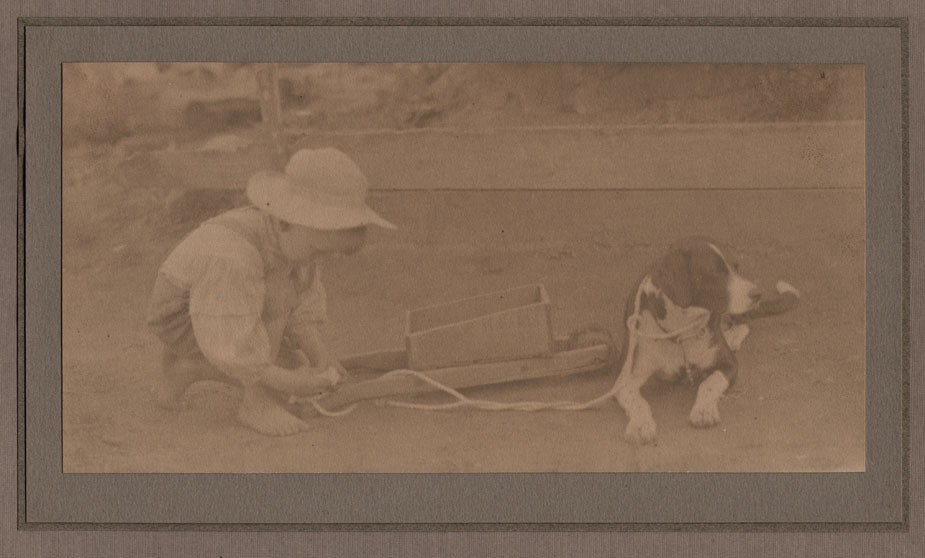 “Playmates”: William T. Knox, American: (1863-1927) Vintage sepia Platinum print ca. 1905-10; image: 12.0 x 23.5 mounted on fine art papers: 19.6 x 24.5 | 19.6 x 24.5 cm. This fine children’s genre study by Brooklyn Camera Club president William T. Knox dates to 1905 or slightly before as it was known to have been exhibited in the Second American Photographic Salon that year. It shows a young child attaching a leash from his faithful canine companion to his toy wooden wheelbarrow. From: PhotoSeed Archive
“Playmates”: William T. Knox, American: (1863-1927) Vintage sepia Platinum print ca. 1905-10; image: 12.0 x 23.5 mounted on fine art papers: 19.6 x 24.5 | 19.6 x 24.5 cm. This fine children’s genre study by Brooklyn Camera Club president William T. Knox dates to 1905 or slightly before as it was known to have been exhibited in the Second American Photographic Salon that year. It shows a young child attaching a leash from his faithful canine companion to his toy wooden wheelbarrow. From: PhotoSeed Archive
Frame Conservation: A Few Ideas
For framed works, conservation on my end typically includes the removal of acidic frame backing materials and replacement with acid-free mounting materials that come into direct contact with the physical print. Embedded dirt and other foreign matter is then carefully removed and or wiped away from the frame itself, with original finishes showing the passing of decades left deliberately intact and never stripped off. Finally, everything is put back together for storage or display: the original glass from the frame is also cleaned on both sides and then carefully put back into place. If cracks are discovered or worse, replacement with a custom cut piece of window glass will typically suffice.
Digital Presentation on PhotoSeed
For digital presentation on this website, the frame is then photographed separately and the print scanned. I use Photoshop to combine the two-leaving the original framing glass out. Purists may object to this but I’m not changing the physical object in any way-just taking advantage to present you with an optimum web experience. Of course, the joy of collecting is being able to appreciate a vintage photograph in the very best form possible: in person. Never the less, I’ve included a small photo along with three other conservation snaps in this post showing a small display of conserved and “reframed” works from this archive. Other examples can be found here.
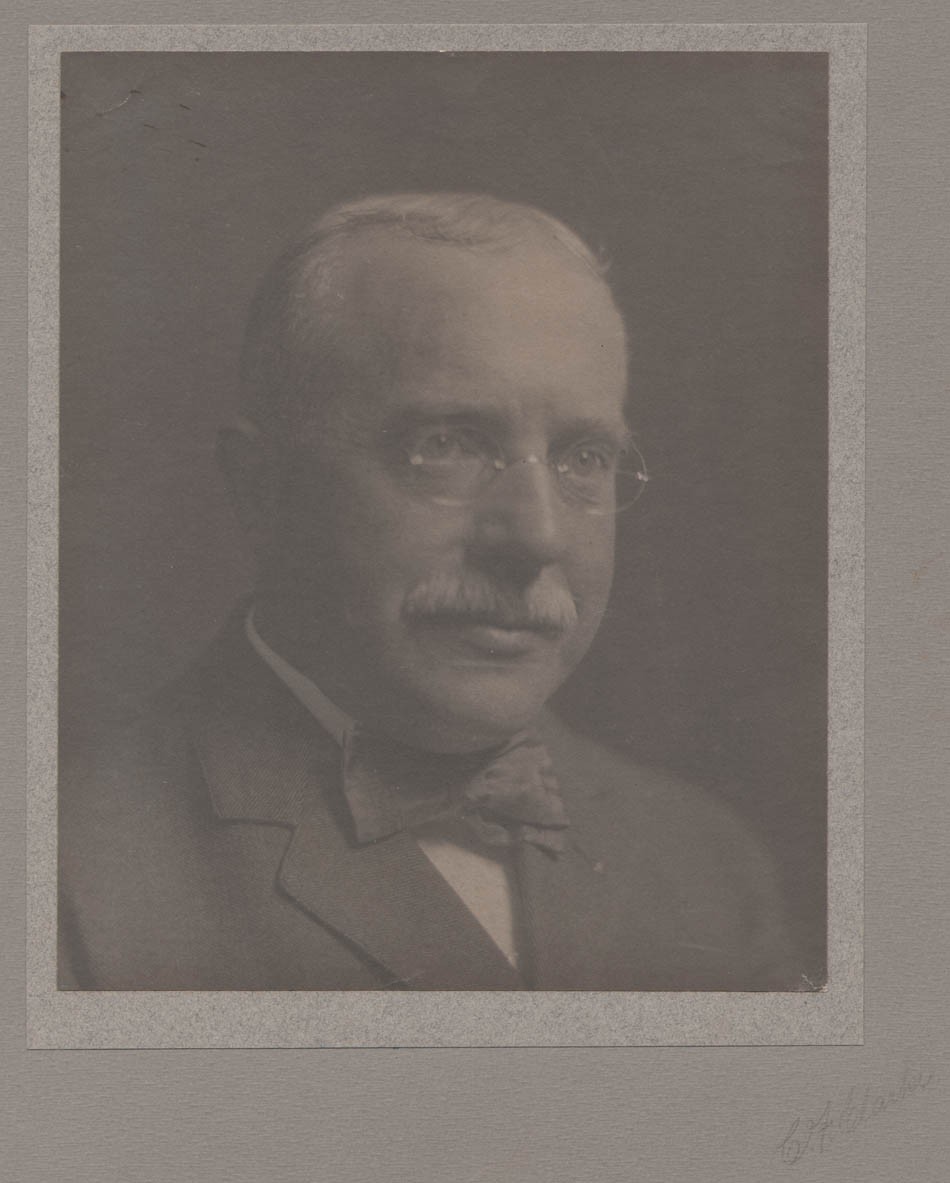 “Portrait: Brooklyn Camera Club President William T. Knox”: Charles Frederick Clarke, American, born Nova Scotia: (1865-1912) image: 21.7 x 17.8 cm; supports: light-gray art paper 23.7 x 19.4 | 36.4 x 29.5 cm; Vintage platinum print ca. 1905-10. William T. Knox (1863-1927) was an important American amateur photographer and promoter of photography from Brooklyn, New York. From at least 1891-1915, he was a partner of McCormick, Hubbs & Co., importers and commission merchants in West India and Florida Fruits and Produce with offices at 279 Washington Street in New York City. (Manhattan) From: PhotoSeed Archive
“Portrait: Brooklyn Camera Club President William T. Knox”: Charles Frederick Clarke, American, born Nova Scotia: (1865-1912) image: 21.7 x 17.8 cm; supports: light-gray art paper 23.7 x 19.4 | 36.4 x 29.5 cm; Vintage platinum print ca. 1905-10. William T. Knox (1863-1927) was an important American amateur photographer and promoter of photography from Brooklyn, New York. From at least 1891-1915, he was a partner of McCormick, Hubbs & Co., importers and commission merchants in West India and Florida Fruits and Produce with offices at 279 Washington Street in New York City. (Manhattan) From: PhotoSeed Archive
Intriguingly, I have owned a platinum portrait of William T. Knox, showing him to be quite the dapper gentleman- mustachioed, and sporting a bow tie taken about the same time he was club president, for many years prior to my collecting any of his actual photographs. This was by Charles F. Clarke, 1865-1912, (American, born Nova Scotia) an amateur and business agent for the Forbes Lithograph Company of Springfield, MA.
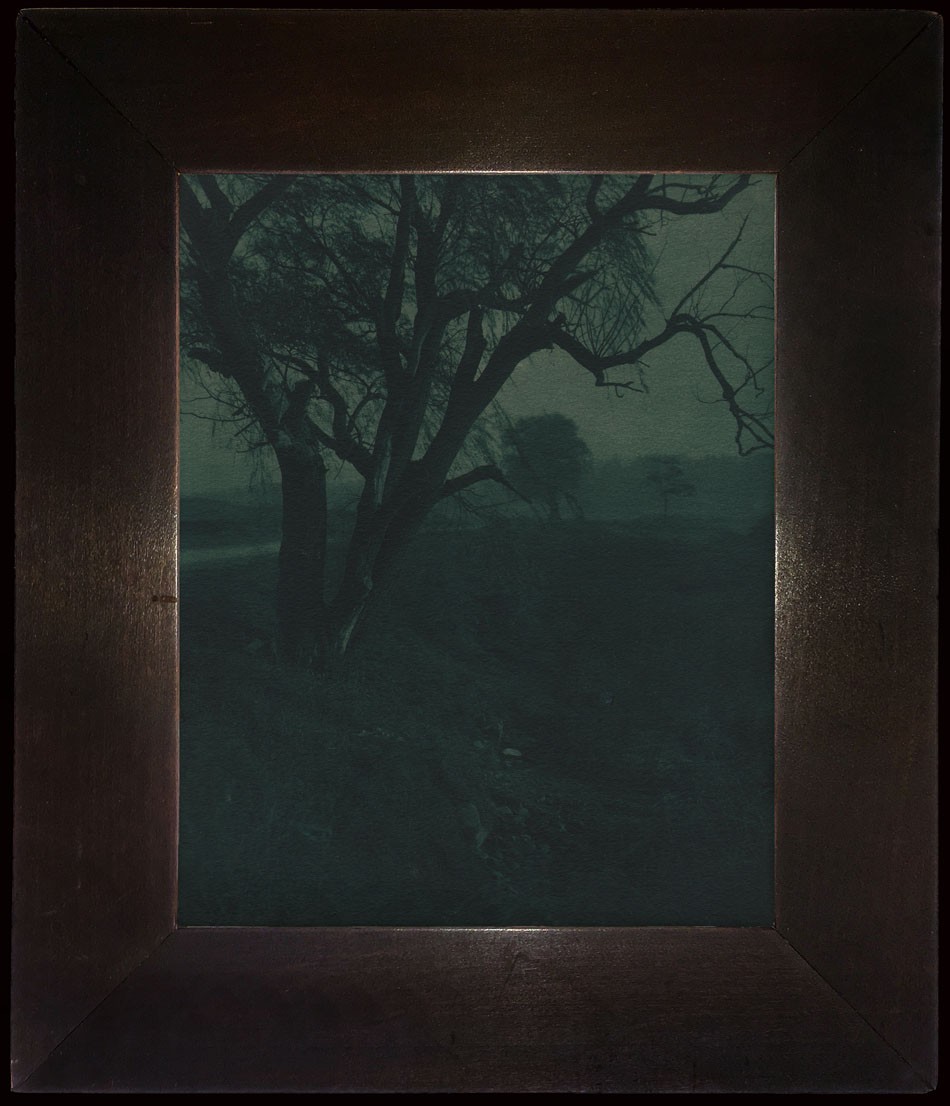 “Landscape in Green Carbon”: attributed to William T. Knox, American: (1863-1927) Vintage green Carbon print ca. 1905-10; image: 23.4 x 19.7 cm flush mounted to thick, Bristol-board type matrix: 23.6 x 19.7 cm shown within its’ original oak frame: 32.6 x 28.6 x 2.0 cm (with glass removed) by James E. Underhill (1870-1914) of New York City. Knox and Underhill were members of the Brooklyn Camera Club when this photograph was taken and framed. From: PhotoSeed Archive
“Landscape in Green Carbon”: attributed to William T. Knox, American: (1863-1927) Vintage green Carbon print ca. 1905-10; image: 23.4 x 19.7 cm flush mounted to thick, Bristol-board type matrix: 23.6 x 19.7 cm shown within its’ original oak frame: 32.6 x 28.6 x 2.0 cm (with glass removed) by James E. Underhill (1870-1914) of New York City. Knox and Underhill were members of the Brooklyn Camera Club when this photograph was taken and framed. From: PhotoSeed Archive
You can see all of Mr. Knox’s framed works in the collection here, which includes a professional chronology for his friend the framer and fellow Brooklyn Camera Club member James E. Underhill. Happy hunting! -David Spencer
The Beautiful Beyond
Posted September 2017 in Childhood Photography, Documentary Photography, PhotoSeed
PhotoSeed celebrates the life of one of its profound influences on the recent passing of my father Charles Edward Spencer 1925-2017.
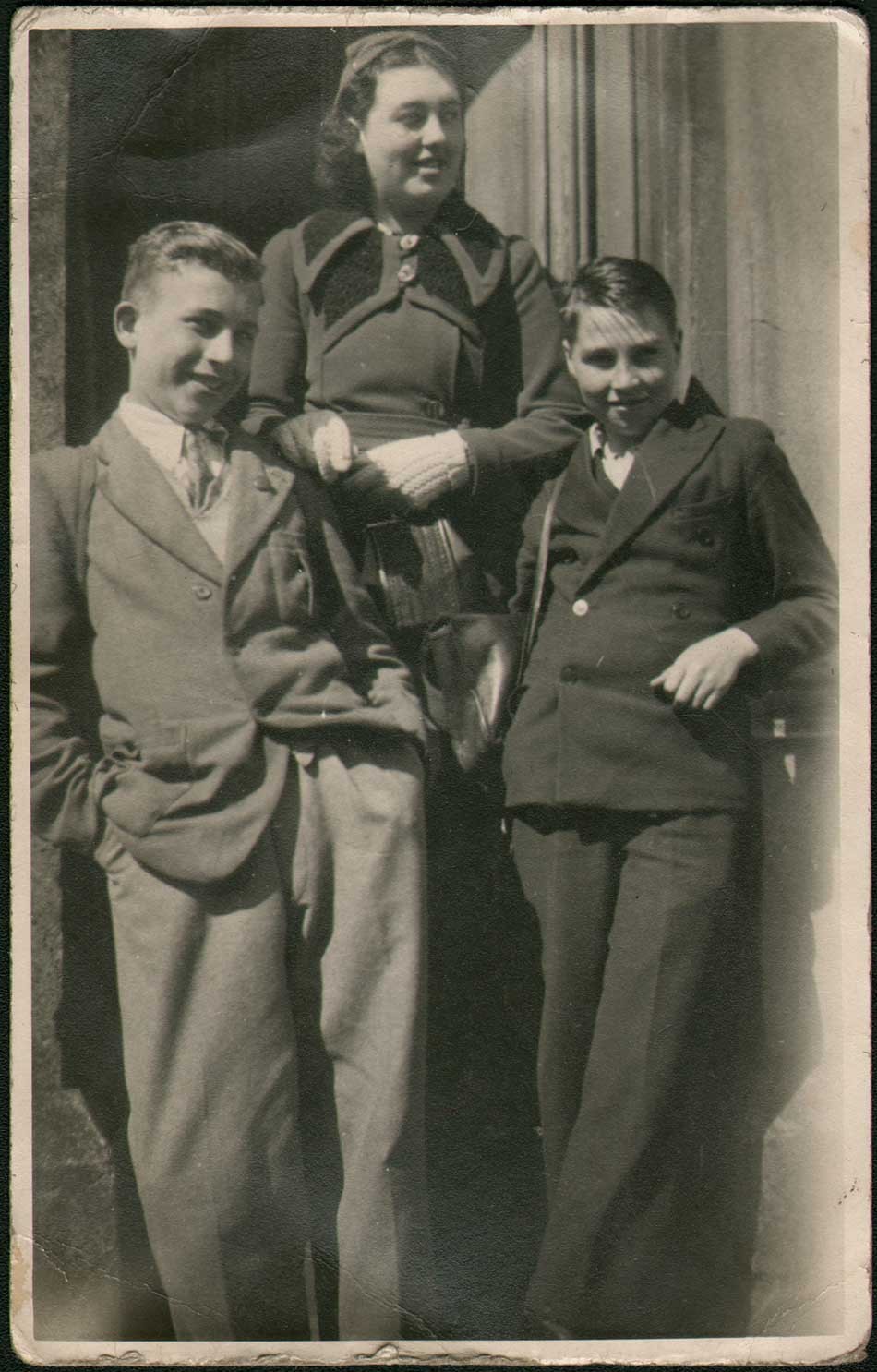 "Charlie Spencer and WWII Classmates" : unknown English photographer: gelatin silver K(odak) Ltd postcard ca. 1940: 13.8 x 8.7 cm : The author's father, about 15, is seen at far left striking a pose in Workington, on the west coast of Cumbria England (Cumberland county) during the early part of World War II. Born in Holyoke, Massachusetts in 1925 to English parents who sought their fortune in the United States, the American Depression forced the family back to their native Newcastle upon Tyne by 1933. A favored German aerial target during the war because of its important shipbuilding industry, Charlie was evacuated along with over 800,000 English school age children from Newcastle and other large English cities beginning in late 1939 as part of the British government's Operation Pied Piper, which eventually displaced 3.5 million people in the UK. Late in the war, he returned to Newcastle, (Benwell) reuniting with his parents Charles and Jane (Garland) Spencer and graduating there from Atkinson Road Technical School. An American by birth, he soon found himself serving in the U.S. Army of Occupation in Germany, where he was a reporter for the Stars and Stripes newspaper among other duties. His first eight years in America had certainly made an impression however, and he returned to the states for good in early 1949 aboard the troop ship USNS General Maurice Rose. Settling in the greater Bridgeport, CT area, he went on to become an advertising and sales promotion specialist for the General Electric Company in their small appliance division for fifteen years and later in the same capacity with other business ventures in CT. Married 61 years to Ann, he passed away in September, 2017. Note: girl in photograph is daughter from Workington family with whom Charlie stayed with during his billet. After Workington, he was billeted with another family in Siddick England. From: Authors personal family archive.
"Charlie Spencer and WWII Classmates" : unknown English photographer: gelatin silver K(odak) Ltd postcard ca. 1940: 13.8 x 8.7 cm : The author's father, about 15, is seen at far left striking a pose in Workington, on the west coast of Cumbria England (Cumberland county) during the early part of World War II. Born in Holyoke, Massachusetts in 1925 to English parents who sought their fortune in the United States, the American Depression forced the family back to their native Newcastle upon Tyne by 1933. A favored German aerial target during the war because of its important shipbuilding industry, Charlie was evacuated along with over 800,000 English school age children from Newcastle and other large English cities beginning in late 1939 as part of the British government's Operation Pied Piper, which eventually displaced 3.5 million people in the UK. Late in the war, he returned to Newcastle, (Benwell) reuniting with his parents Charles and Jane (Garland) Spencer and graduating there from Atkinson Road Technical School. An American by birth, he soon found himself serving in the U.S. Army of Occupation in Germany, where he was a reporter for the Stars and Stripes newspaper among other duties. His first eight years in America had certainly made an impression however, and he returned to the states for good in early 1949 aboard the troop ship USNS General Maurice Rose. Settling in the greater Bridgeport, CT area, he went on to become an advertising and sales promotion specialist for the General Electric Company in their small appliance division for fifteen years and later in the same capacity with other business ventures in CT. Married 61 years to Ann, he passed away in September, 2017. Note: girl in photograph is daughter from Workington family with whom Charlie stayed with during his billet. After Workington, he was billeted with another family in Siddick England. From: Authors personal family archive.
The call would come, I had convinced myself, for years. But it waited patiently. I reassured myself I was prepared, but for naught. When it did, from my brother Will, it was from his childhood voice over 50 years gone: punctuating his cries through the distance, he gasped for breath: “Dad did not wake up” he somehow forced through his cracking voice, cries and tears. My own response immediate: a shuddering to my core equal to his-helpless feelings not revisited since my toddler days-cries my father was now unable to comfort as he did throughout my entire life ⎯the finality of it all.
But goodness had shined its light, in this most profound form of sudden loss: my dad was now truly free of any miseries real for him in the physical present, and ones our family perceived in him during his long and noticeable decline. Vanquished. He was now free, and on his journey to the beautiful beyond.
David Spencer-
Support our Vision, Validate our Passion
Posted March 2017 in Advertising, Childhood Photography, Documentary Photography, PhotoSeed, PhotoSeed Gallery
Like what you see on PhotoSeed? Have you ever thought of collecting vintage photographs? It might seem strange for some in our modern age of digital connoisseurship, where family photo albums now reside, along with everything else, on your smartphones. But actual physical photographs, unlike their digital brothers and sisters, do actually stand the test of time. You can even hang them on your wall!
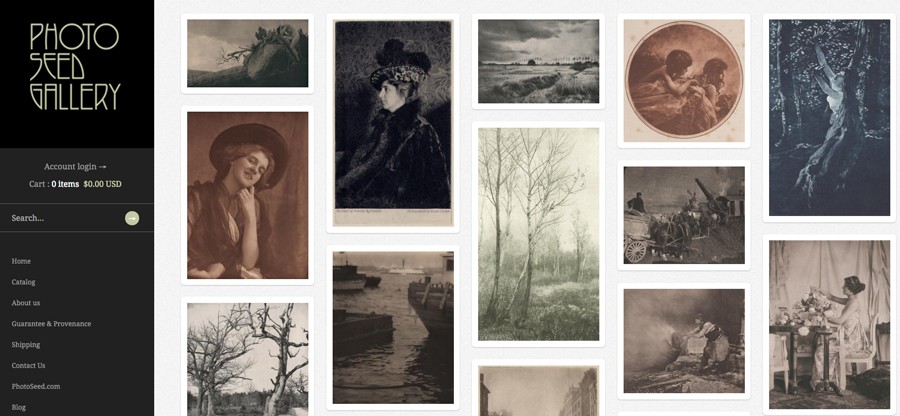 Screengrab of the homepage for the PhotoSeed Gallery website hosted by Shopify e-commerce online platform: March, 2017
Screengrab of the homepage for the PhotoSeed Gallery website hosted by Shopify e-commerce online platform: March, 2017
If you’ve arrived here by chance, or are a long-time visitor, you might have thought that some of these digital photographs are quite beautiful. Wouldn’t it be nice to…perhaps, acquire an original for yourself, a friend or loved one? Well today is your lucky day. After nearly two decades of collecting, I’m going in a new direction and launching PhotoSeed Gallery. The new venture is designed to give anyone in the world (we ship internationally) the opportunity to purchase vintage photographic works of art (never reproductions) created from roughly 1885-1920. Heck, you don’t even need to leave home to do it. A desktop computer will give you the best feel and display for the site, but if you insist, that aforementioned smartphone will also do the trick nicely from anywhere.
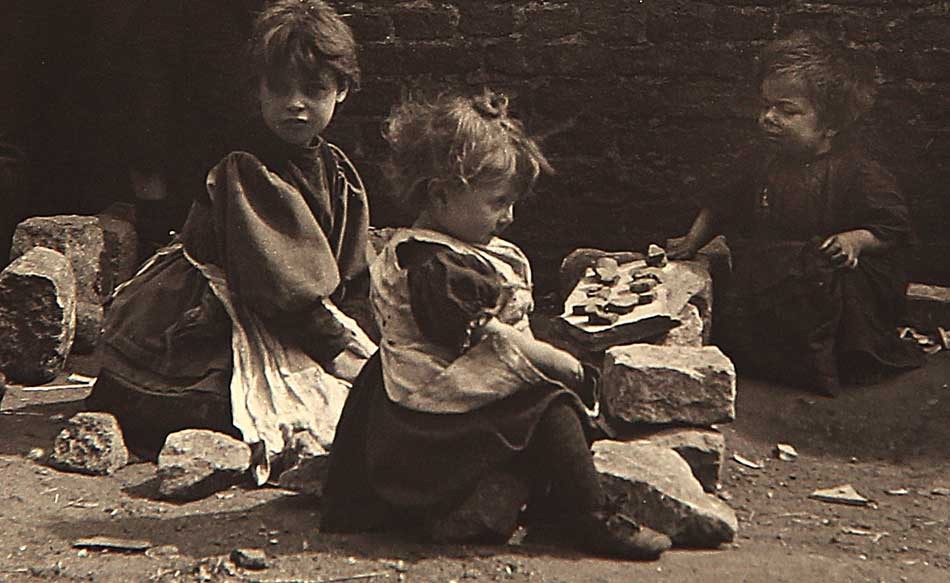 Detail: Playing at Shops: Edgar G. Lee, English: (1860-1915) vintage exhibition lantern slide ca. 1895-1905: 8.2 x 8.2 cm. A portrait photographer by trade, Englishman Edgar Lee was an active exhibitor in the Royal Photographic Society Salons from 1890-1903. The body of work he is best remembered for however is documentary, with 300 of his lantern slides held in the Woodhorn Museum and Northumberland Archives chronicling the residents, mostly poor, of the Quayside area of Newcastle upon Tyne. PhotoSeed owns several examples of Lee's work, including this street view showing a group of little girls- with two clad in white aprons at front and left- pretending to sell what appears to be an assortment of rocks or broken tiles arranged on a table made from slate and rocks. Interestingly, a postcard of this image: "Playing at Shops: The Slums, Sandgate" was later published by his Newcastle firm Thompson and Lee, the work possibly part of his earlier documentary involvement with investigations conducted by the Royal Commission on the Poor Laws and Relief of Distress in England held from 1905-09. From: PhotoSeed Archive
Detail: Playing at Shops: Edgar G. Lee, English: (1860-1915) vintage exhibition lantern slide ca. 1895-1905: 8.2 x 8.2 cm. A portrait photographer by trade, Englishman Edgar Lee was an active exhibitor in the Royal Photographic Society Salons from 1890-1903. The body of work he is best remembered for however is documentary, with 300 of his lantern slides held in the Woodhorn Museum and Northumberland Archives chronicling the residents, mostly poor, of the Quayside area of Newcastle upon Tyne. PhotoSeed owns several examples of Lee's work, including this street view showing a group of little girls- with two clad in white aprons at front and left- pretending to sell what appears to be an assortment of rocks or broken tiles arranged on a table made from slate and rocks. Interestingly, a postcard of this image: "Playing at Shops: The Slums, Sandgate" was later published by his Newcastle firm Thompson and Lee, the work possibly part of his earlier documentary involvement with investigations conducted by the Royal Commission on the Poor Laws and Relief of Distress in England held from 1905-09. From: PhotoSeed Archive
Many websites solicit funding via one of those “donate here” buttons for their upkeep and survival. I can appreciate that, but somehow, in my humble estimation, it is so much better to support your love of photography by receiving something in return: in this case, tangible and real photographs. Going forward, gallery sales will be vital and necessary for maintaining PhotoSeed’s core mission of bringing attention to the often obscure and forgotten practitioners from photography’s past, as well as the critical and time-consuming scholarship their work demands in giving it the proper due it deserves for the larger historical record. And no worries, I’m a collector myself at heart, so our intent will always be the continual addition of rare and surprising examples to this record in the coming years.
Thanks for stopping by, and please consider a purchase to support our vision and validate our passion.
-David Spencer PhotoSeed Archive & Gallery owner and curator March, 2017
In with the New
Posted January 2016 in New Additions, PhotoSeed, Typography, Unknown Photographers
A Merry Christmas to All
Posted December 2015 in Engraving, Painters|Photographers, PhotoSeed, Publishing, Typography
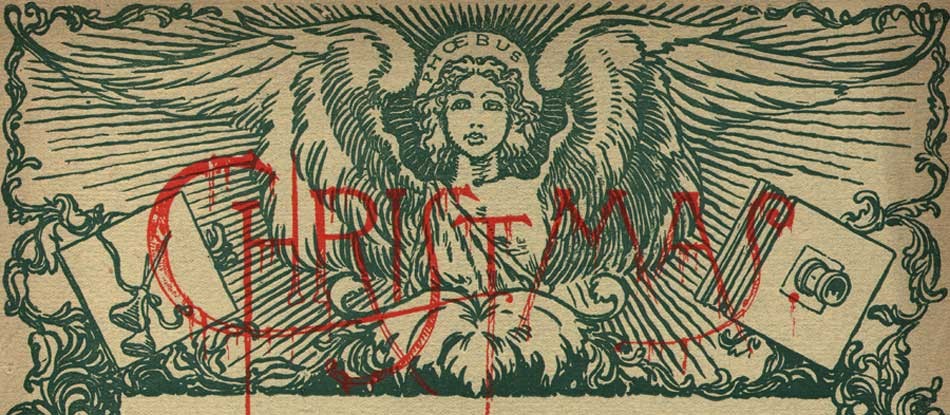 Detail: "Phoebus": by George Wharton Edwards: American 1859-1950: multiple-color woodcut used as part of cover illustration for periodical "Sun & Shade": New York: December, 1890: whole #28: N.Y. Photo-Gravure Co.: 32.1 x 25.3 cm | 35.3 x 28.0 cm: from: PhotoSeed Archive
Detail: "Phoebus": by George Wharton Edwards: American 1859-1950: multiple-color woodcut used as part of cover illustration for periodical "Sun & Shade": New York: December, 1890: whole #28: N.Y. Photo-Gravure Co.: 32.1 x 25.3 cm | 35.3 x 28.0 cm: from: PhotoSeed Archive
 "Christmas Eve": by Sir John Everett Millais: English 1829-1896: photogravure published in periodical "Sun & Shade": New York: December, 1890: whole #28: N.Y. Photo-Gravure Co.: 19.2 x 15.7 cm | 34.9 x 27.2 cm: from: PhotoSeed Archive
"Christmas Eve": by Sir John Everett Millais: English 1829-1896: photogravure published in periodical "Sun & Shade": New York: December, 1890: whole #28: N.Y. Photo-Gravure Co.: 19.2 x 15.7 cm | 34.9 x 27.2 cm: from: PhotoSeed Archive
 Detail: "A Merry Christmas": Emilie V. Clarkson: American 1863-1946: photogravure published in periodical "Sun & Shade": New York: December, 1890: whole #28: N.Y. Photo-Gravure Co.: 20.1 x 14.5 cm | 34.9 x 27.2 cm: from: PhotoSeed Archive
Detail: "A Merry Christmas": Emilie V. Clarkson: American 1863-1946: photogravure published in periodical "Sun & Shade": New York: December, 1890: whole #28: N.Y. Photo-Gravure Co.: 20.1 x 14.5 cm | 34.9 x 27.2 cm: from: PhotoSeed Archive
 Detail: "We Praise Thee O Lord" ("Sang with many a change Christmas carols until morn.": Emilie V. Clarkson: American 1863-1946: photogravure published in periodical "Sun & Shade": New York: December, 1890: whole #28: N.Y. Photo-Gravure Co.: 20.0 x 15.5 cm | 34.9 x 27.2 cm: from: PhotoSeed Archive
Detail: "We Praise Thee O Lord" ("Sang with many a change Christmas carols until morn.": Emilie V. Clarkson: American 1863-1946: photogravure published in periodical "Sun & Shade": New York: December, 1890: whole #28: N.Y. Photo-Gravure Co.: 20.0 x 15.5 cm | 34.9 x 27.2 cm: from: PhotoSeed Archive
 Detail: "Christmas Morning by the Sea" (alt: Winter's Touch on Land And Sea": Mrs. J.M. Appleton: American: photogravure published in periodical "Sun & Shade": New York: December, 1890: whole #28: N.Y. Photo-Gravure Co.: 10.5 x 16.1 cm | 34.9 x 27.2 cm: from: PhotoSeed Archive
Detail: "Christmas Morning by the Sea" (alt: Winter's Touch on Land And Sea": Mrs. J.M. Appleton: American: photogravure published in periodical "Sun & Shade": New York: December, 1890: whole #28: N.Y. Photo-Gravure Co.: 10.5 x 16.1 cm | 34.9 x 27.2 cm: from: PhotoSeed Archive
